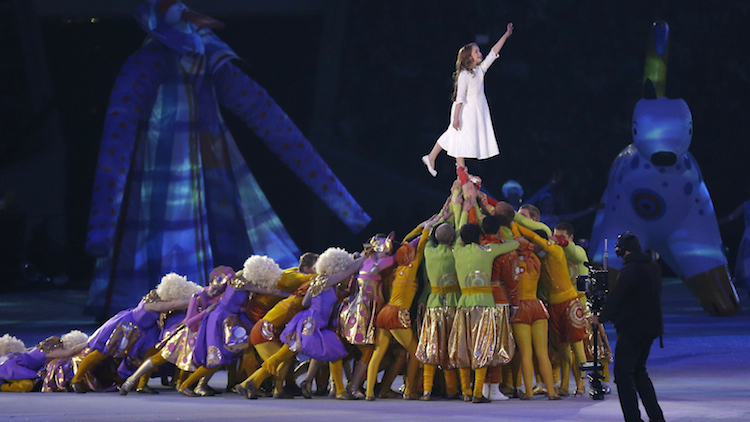Olympic opening ceremony attempts to portray ‘real Russians’
And it’s not an easy task
Performers raise a young girl into the air during the opening ceremony of the 2014 Sochi Winter Olympics, February 7, 2014. REUTERS/Phil Noble (RUSSIA – Tags: OLYMPICS SPORT) – RTX18D0G
Share

Konstantin Ernst, executive creative director of the whimsical, wonderful opening ceremony of the Sochi Winter Olympics promised to showcase “the new Russia.” To do so he reached back into the distant past, to the times of Ivan the Terrible and Peter the Great, to tsars and revolution, to Bolsheviks and ballet.
“I wanted people all over the world to meet, understand and know us, as Russians,” he explained. “The real Russians, untainted by decades of propaganda and the Cold War.”
The only cold on a Sochi Friday night was a chill breeze off the Black Sea. Ernst, his team, and a cast of 3,000 artists, actors and acrobats took Russia’s unruly, blood-soaked history and spun a magical, mystical fantasy.
It was a daunting job to capture, in less than three hours, the soul a country that sprawls across nine time zones, and of 114 million people of 150 enthnicities and an often-brutal past. He can be forgiven for speeding past the bloody bits, or transforming them into artful allegory; one does not invite the world to view one’s dirty laundry. And certainly not with President Vladimir Putin in attendance.
RELATED
- The best photos from the opening ceremony
- Russia, that uncontroversial land of non-drama
- We sent a sketch artist to cover the opening ceremonies
The story’s theme, Dreams of Russia, used a young girl, Lubov (Love in Russian) as the thread to draw viewers through the narrative. It weaved through medieval folk symbols and mythical creatures. Helium-filled inflatables formed the magnificent domes and roofline of St. Basil’s Cathedral. (Where, as program notes point out, legend has it Ivan the Terrible blinded the architect who designed it in 1552 so he could never replicate its beauty.)
There was a celebration of the late 17th century era of Peter the Great, who as tsars go, was one of the good guys, modernizing and expanding Russia. There was a nod to Tolstoy’s War and Peace, staged as a grand dance by some of Russia’s renowed ballet stars, telling the tales of heroism and loss during the Napoleonic wars. There were allusions to the Russian Revolution of 1917, and the rise of avant-garde art. A speeding train flying across the sky symbolizing “this seminal and productive time.” Far better than focusing on purges, gulags and other unpleasantries.
That’s the thing with Russia, as the show so beautifully portrayed. In good times and bad there is always great literature, art, song and dance to nourish the Russian soul. It was all on display from Tchaikovsky’s Swan Lake, to the modern music of the racy female duo of t.A.T.u—no fans of Russia’s new laws against the promotion of homosexuality.
Visually, the ceremony was stunning, though, as is often the case for those who spend large for opening ceremony tickets, it is best viewed on the television with a billion or so of your closest friends. It’s a conundrum all directors of such spectacles face: do you play to the 40,000 shivering souls in attendance, or do you make pretty pictures for broadcast?
As Ernst candidly admits, at every cross-road in the production, he veered toward the needs of the broadcast audience, where a troika of thundering horses can convincingly haul the sun across the heavens, where an inflatable whale floats in a projected sea, and hundreds of people in lighted costumes can make a spectacular waving Russian tricolour flag—if viewed from high above.
Perhaps it was the lure of a better televisual experience that explained a significant number of empty seats for an event that in most Olympiads is a sold out spectacular. More likely, the decision for Russians to watch from home had something to do with the threats of terrorist attacks. What better way to derail Putin’s Olympics that on opening night? That it didn’t happen speaks well of Putin’s Ring of Steel security measures. Or perhaps the Islamic extremists know that empty threats are an easier and still effective way of raining on the parade.
In the end, the only explosions came from 22.5 ground-shaking tonnes of fireworks that were blasted off in a spectacular finale. It came after the best-kept secret of the night was revealed: the sweeping, graceful Olympic cauldron was lit from the torches of two two legendary sports heroes: figure skater Irina Rodnina and goalie Vladislav Tretiak. Fire and ice; Russia’s history in a nutshell.